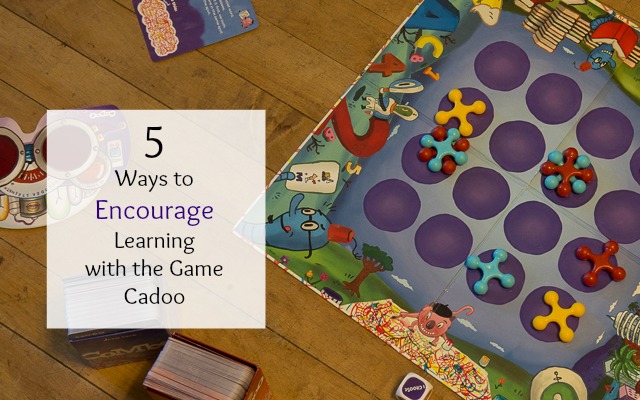5 Ways to Encourage Learning with the Game Cadoo


Board games offer an opportunity to make learning fun. I love integrating them into our homeschool days. While we do occasionally play games according to the rules, we most often just use the components of a game as learning tools.
Ditching the rules sparks creativity. It allows children to explore freely, and come up with their own ways to play. I enjoy seeing what my kids come up with!
One game we’ve been using frequently is Cadoo from Cranium. Here are five different ways it’s helped encourage learning in our homeschool.
1. Patterning
The colorful pieces in Cadoo are meant to be played with! They’re large enough I feel comfortable letting my younger kids play with them, so they do.
We’ve worked on patterning with these pieces. Using the game board, I’ll start a simple AB pattern and ask a child to finish it. Then we switch roles, and they start a pattern.
Once AB patterns become easy, we move onto harder patterning patterns. With 40 tokens and several color choices, the fun lasts quite a while!
2. Reading Practice
The 3-D glasses included in the game make reading so much more fun! My early readers are eager to practice when I hand them the glasses and a box of cards.
There’s a question with some possible answers on the front of each card. The back has the answer, but you must use the 3D glasses to reveal it. I’ve heard my kids reading some pretty hard words, just because they wanted to use those special glasses!

3. Addition and Subtraction Practice
Manipulatives help students gain a better understanding of math concepts. The tokens in Cadoo make the perfect sized math manipulative!
My early elementary aged kids create their own story problems, using the tokens as props. They also use them to practice their addition and subtraction facts. One child plays the role of teacher, calling out the problems. Another uses the tokens and gives an answer. Then they switch.
4. Time Estimation
It’s important to estimate how long it’s going to take you to do a task. As my kids decide what they’re going to do “before the timer runs out,” they begin to see what can realistically be done in a short amount of time.
They enjoy stretching the limits, challenging their siblings to beat the clock as they:
● Work through a quick obstacle course
● Sing the ABC song three times
● Go find five red objects
● Build a tower with all the LEGOs in that pile
At first, they often came up with unrealistic challenges. But, as they’ve continued practicing, they’re learning how to estimate the length of time a challenge will take.
5. Creative Storytelling
The cards are full of ideas to spark creative storytelling. Sometimes my kids will each pick five to ten of the Solo cards. Then, they’ll have to tell a story including at least one object from each card.
Learning how to weave unrelated people, places, or things into a story helps strengthen the same muscle used for creative writing later. For instance, what story could you tell using these things:
● Snow White
● A tyrannosaurus rex
● A fly
● Something sticky
● A hot air balloon
One of my children created an entertaining tale about Snow White traveling back in time in a hot air balloon time machine. The balloon got a hole and she got stuck in the past. There she encountered a pesky tyrannosaurs rex, a gigantic fly, and a prickly cactus. She finally made it home by using sticky chewing gum to patch the hole.
Creative Thinking
When you allow your kids to explore with game pieces, you’re helping them learn to think outside the box. This creativity will serve them well throughout their lives!
Lisa Tanner is a homeschooling mom of eight. She loves writing about balancing diapers and deadlines, and ways to make learning fun.














































